Why Beginners Should Use Wood Carving Patterns
If you are new to the world of wood carving, it can feel overwhelming with so much to learn, especially about the various tools and their uses. When starting out, it is best to keep things simple. There are plenty of wood carving ideas out there, but the key is to choose one that you can successfully complete. If the project is too complex, you might get discouraged and lose motivation to take on new wood carving projects. So, what's the solution? Try starting with wood carving patterns.
How Patterns Help Build Foundational Skills
Utilizing carving patterns is a great way to make carving easier and streamline your learning process.
Wood carving patterns help translate two-dimensional images into three-dimensional forms, guiding you on how to carve each line. They teach you to concentrate and achieve the desired level of accuracy by bringing simple wood whittling ideas to life.
Easy wood carving ideas help beginner carvers understand proportions while honing their skills with a whittling kit. While carving patterns provide a starting point, they also encourage creativity. By trying your hand at beginner wood carving projects, you can experiment with variations and develop your own unique style. This will help build confidence and provide sufficient practice so that you can create smooth curves, efficiently remove excess wood, refine shapes, and add subtle features.
Benefits of Using Pre-Designed Templates
Wood carving templates can guide you in creating detailed projects while saving time on planning and preparation. Whether you are exploring things to whittle as a hobby or working on more intricate projects, templates offer clear advantages:
- Accuracy and Consistency: Pre-designed templates ensure precise measurements and consistent shapes, making even simple wood carving designs look professional. Patterns often use grids and reference lines to align different parts (front, side, top views) on the wood block. Proper alignment ensures the final carving looks natural and symmetrical. If a pattern lacks reference lines, you may add them manually, marking key points (e.g., beak tip, tail).
- Getting a Feel for 3D and 2D Patterns: Understanding both three-dimensional and two-dimensional patterns is essential for mastering wood carving. 3D patterns help you visualize the depth and contours of your project, while 2D patterns provide a clear outline to follow.
- Versatility: Templates are adaptable to different materials and can be reused for multiple projects, from easy things to whittle to advanced sculptures.
- Reduced Errors: By following pre-set whittling patterns, you minimize mistakes, ensuring your final project aligns with the intended shape and details.
- Time-Saving: Templates reduce the time spent sketching or planning your project, allowing more time for actual carving.
- Inspiration for New Projects: Using free whittling patterns for beginners introduces you to various carving styles and expands your wood carving ideas beyond basic shapes.
Top 5 Easy Wood Carving Patterns for Beginners
Starting with simple wood carving ideas doesn't mean doing boring stuff. On the contrary, the more shapes and dimensions you carve or whittle, the better. These are just a few examples of carving and whittling projects you can do to develop a wide skill set.
Simple Animal Shapes
Example: A bird, fish, rabbit, or turtle.
These wood carving ideas for beginners focus on basic forms and smooth curves. By carving fish, you can practice creating flowing lines. Carving rabbits helps you shape and refine curves. Turtles let you experiment with different textures.

Geometric Designs
Example: Stars, triangles, spirals, or diamonds.
These patterns will help you improve precision and control over the carving tools. The repetitive nature of geometric shapes helps you develop muscle memory and a steady hand while whittling wood.
Nature-Inspired Patterns
Example: Leaves, flowers, trees, or animals.
Nature-inspired patterns are often among the top choices for easy whittling projects. These patterns are essential for learning to add fine lines, practice symmetry, and maintain correct proportions. When learning to whittle such patterns, use light, controlled cuts. Focus on the basic shape first, and then carve the details.

Functional Carving Projects
Example: Small spoons, keychains, or ornaments.
Such beginner whittling projects let you experiment with shapes and refining curves. Before starting to carve, sketch your design on the wood, ensure you have all the necessary wood carving knives at hand, start by rough shaping the wood piece well, pay attention to the direction of the grain, and make each cut thoughtfully. Remember to sand the surface when shaping is complete and add oil to protect the wood.
Abstract Shapes
Example: Waves, curves, or asymmetrical designs.
Abstract wood carving patterns help you understand how different forms interact. They encourage you to explore basic design principles and see how various woods, carving tools, and finishes can achieve the desired outcome.
Where to Find Free Wood Carving Templates
There are numerous resources available to help you find beginner step by step wood carving patterns and instructions. Carving books and magazines often include detailed patterns and guides. Pinterest can be your go-to resource for inspiration and also printable or downloadable carving patterns. These are just a few resources to inspire your next carving projects.
Online Resources for Free Patterns
Why It Is Good: This YouTube channel offers a wealth of free wood carving templates, from simple geometric designs to intricate portraits. You will find line drawings, stencil wood carving patterns, and even 3D models, all accompanied by helpful tutorials. This resource caters to all skill levels, providing a diverse range of options for both beginners and experienced carvers.
- Resource: Lora S. Irish
Why It Is Good: This website is a treasure trove for woodcarvers of all levels, particularly those interested in chip carving and exploring flat wood carving ideas. Lora S. Irish is a renowned woodcarving instructor, and her site offers a wealth of free resources, including detailed tutorials and helpful tips for beginners. You will also find wood carving stencils and templates there.
Downloadable PDFs or Printable Options
- Resource: Carving is Fun
Quick Overview: This website offers a collection of free downloadable templates and patterns for wood whittling and carving enthusiasts. Whether you are looking to carve animals, objects, or try out relief carving, this website has something to offer.
- Resource: The Woodcarver’s Cabin
Quick Overview: This resource shares a variety of free and easy wood carving patterns, including animals, nature-inspired designs, and geometric shapes. They also provide tutorials and tips to help you get started.
Tips for Whittling Success as a Beginner
When selecting your wood carving pattern, take a moment to plan your next steps. Thoughtful preparation can make the carving process far more enjoyable. Ensure your pattern has distinct guiding lines to help you stay on track as you carve. Choose a piece of wood that is easy to carve yet durable enough to hold smaller details. A reliable beginner wood carving knife set will help you achieve clean and precise cuts, making your carving experience more rewarding. Here are a few more tips to help you succeed.
Start Small and Keep It Simple
To begin with, you may want to start with a few very easy whittling projects. This is essential for gradually gaining more experience and practicing various carving and whittling techniques to move on to the next level. Here are some tips to help simplify things for you:
- Choosing the Right Wood:
The wood block must be large enough to accommodate the entire carving pattern. If you use a large wood piece, rough shape it to the needed size before transferring the pattern. Alternatively, you may want to use a pre-cut wood blank, which will eliminate the rough shaping burden. Speaking of wood types, basswood is the best wood for whittling, known for its softness and ability to retain details.
- Using Patterns on Wood Blocks:
- Patterns can be photocopied, resized, and wrapped around a wood block to guide carving.
- Adhesive spray is used to attach patterns to wood temporarily before cutting.
- Leave some excess wood around the pattern to prevent mistakes during sawing.
- Use reference lines.
Use the Right Tools (link to tools page)
When it comes to carving tools, follow the same principle: start with a minimal whittling knife set or even just one bench knife. Have regular carving sessions, then try other techniques and gradually add more tools to your wood carving kit.
An example of a one-tool project could be carving a wizard. For this, you may only need an 11/2 inch bench knife to do all the carving, a pencil for drawing guidelines, a ruler for measuring dimensions, and some sharpening supplies like a leather strop for maintaining the wood carving knife.
At forgedsteeltools.com, we offer a wide range of wood carving tools for beginner projects. From individual whittling knives to complete carving sets with wooden blanks and leather strops, we have everything you need to get started. These are just a few examples of sets you can come across:
#1. Hand-Forged Wood Carving Tool Set with Wooden Blanks WS9
What's Included:
- Small Chip Carving Knife: Blade length: 4 cm (1.6 in)
- Whittling Sloyd Knife: Blade length: 7 cm (2.8 in)
- Wooden Blanks: Blank 1 (2 pcs), overall length 15 cm (5.9 in)
Beginner Projects:
- Small animals
- Simple spoons
- Ornaments
#2. 3-Piece Hand-Forged Wood Carving Tool Set
What's Included:
- Roughing Knife #1: Blade length: 5 cm (1.97 in)
- Long Bent Gouge #2: Blade length: 9 cm (3.54 in)
- Straight Chisel #3: Blade length: 8 cm (3.15 in)
Beginner Projects:
- Basic bowls
- Relief carvings
- Simple figures
#3. Hand-Forged Wood Carving Tool Set with Wooden Blanks
What's Included:
- Small Chip Carving Knife: Blade length: 4 cm (1.6 in)
- Whittling Knife: Blade length: 7 cm (2.8 in)
- Long Bent Gouge: Blade width: 10 mm (0.39 in)
- Wooden Blanks: Lengths: 5 cm (2 in)-15 cm (5.9 in)
Beginner Projects:
- Decorative plaques
- Whittled animals
- Bowls and cups
You are sure to find something useful for yourself. If any questions arise along the way, just drop us a line in the live chat.
Practice Safe Carving Techniques
Safety in carving is all about using sharp, well-maintained whittling tools and protective gear. Consider wearing safety goggles and gloves to shield yourself from chips and cuts. Keep your workplace well-lit and clean. Practice steady, slow motions and carve away from your body. Use your thumbs to guide the blade and focus on making controlled cuts without rushing.
Take Your Time—Enjoy the Process!
By doing so, you develop a feel for the tools and the wood, leading to better control and cleaner cuts. It also reduces the risk of mistakes and injuries, making the experience safer and more enjoyable.
Conclusion: Showcase Your Work
Learning involves making mistakes and analyzing them to move forward. When you complete your first projects, be sure to share them with the community. You will feel supported and more encouraged to continue. Additionally, seasoned carvers may share hands-on advice to help you progress.
Ideas for Displaying Finished Projects
Consider framing your smaller pieces to create unique wall art that showcases your craftsmanship. Shelves are perfect for displaying larger carvings, allowing you to create a personalized gallery in your home. Alternatively, you can gift your creations to friends and family.
Share Work Online or In a Community
Online platforms and local carving groups provide opportunities to learn new techniques, gain inspiration, and stay motivated. By sharing your work, you can also inspire others and contribute to the vibrant wood carving community.
Get Started Carving
So now, grab a whittle knife and start exploring the endless possibilities of this rewarding craft. Remember, our team is always here to offer advice and recommend the best-suited tools to help you carve more efficiently. Don't hesitate to reach out!
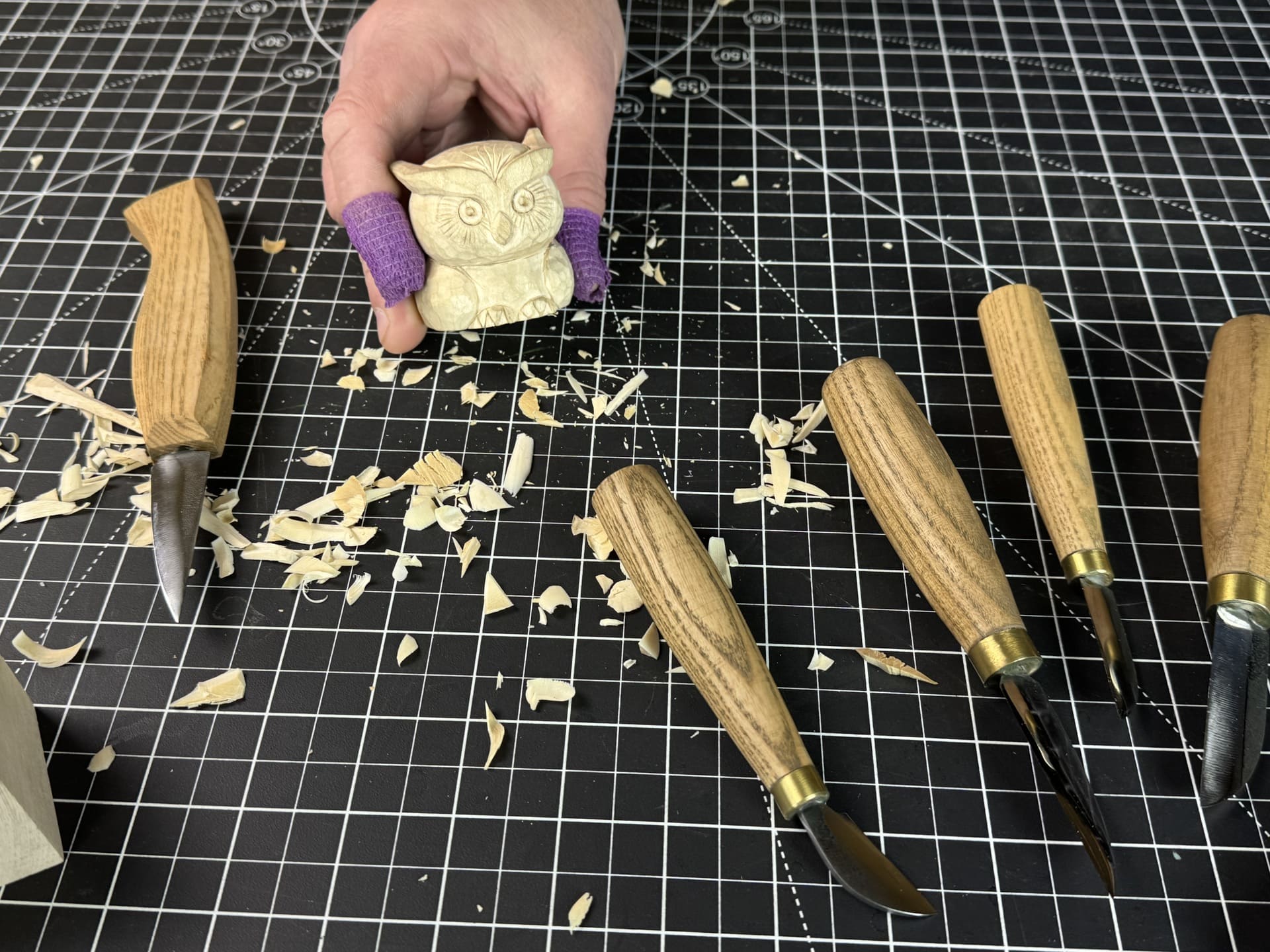
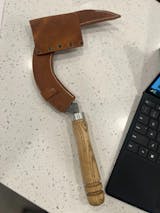
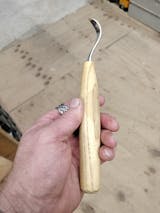
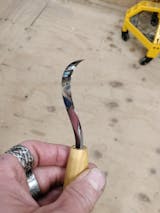
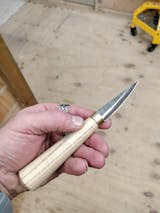
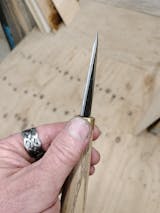
Share:
How to whittle wood? Complete starter guide to whittling
How to Carve a Wooden Spoon: A Detailed Guide on How to Whittle a Spoon